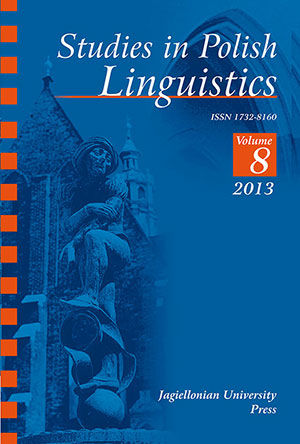Complex verbo-nominal predicates in the light of prototype approaches to categorization
Complex verbo-nominal predicates in the light of prototype approaches to categorization
Author(s): Ewa JędrzejkoSubject(s): Language and Literature Studies
Published by: Wydawnictwo Uniwersytetu Jagiellońskiego
Keywords: periphrastic predication; parts of speech; radial and polycentric categories; metaphor; profiling
Summary/Abstract: The article is an attempt to analyse complex predicates (henceforth VNAs) from the point of view of the prototype theory and the concept of family resemblance (prototype, polycentric and gradable categories). The focus is on the lexical-grammatical status of constructions of the type robić pranie ‘to do the washing’, ulec zniszczeniu ‘to be destroyed’, ‘lit. to undergo destruction’, wpaść w przerażenie ‘to be filled with terror’, ‘lit. to fall into terror’, ponieść klęskę ‘to suffer defeat’ functioning as predicates. Units of this type are clearly structured as [VGENER//METAFOR + NA/NE/NABSTR], highly fossilized (phraseologised) and have considerable derivational potential. Moreover, they are characterized by semantic proximity to full verbs (robić pranie = prać ‘to wash’, wpaść w przerażenie = przerazić się ‘to be terrified’). Units of the VNA type are common cross-linguistically and as such may be seen as a product of a systemic sign-formation mechanism, which complements other (morphological) means of sign-formation. Furthermore, VNAs display strong (semantic, formal and functional) correlations with the V-class. They are produced via nominalization and secondary verbalization of the predicate as well as metaphorical conceptualization of events they denote. Based on the premise that language categories are prototypical in nature (i.e. they are gradable, radial, mono- and polycentric), it is further assumed that the units traditionally recognized as parts of speech (including V and N) also belong to categories with fuzzy boundaries grouped according to their functional (grammatical) identities and family resemblances, in which the center and the periphery can be distinguished. An attempt is made to show that VNAs are located at the periphery of the V-class, constituting a radial polycentric area. VNAs are capable of undertaking the sentence-forming function (like the verb) and enter various mutual semantic relationships (synonymy, antonymy, conversion, gradation, etc.). The linguistic-conceptual (cognitive) mechanism of periphrastic predication is connected with decomposition of the global conceptual content of the predicate and metaphorical conceptualization and image-based profiling of events predicated periphrastically. This brings about multidirectional expansion of the inventory of periphrastic signs (cf. e.g. emotions conceptualized as FIRE: VNA czuć nienawiść ‘to feel hate’ or, metaphorically, wzniecić nienawiść ‘to incite hate’, płonąć nienawiścią ‘to burn with hate’ <> V nienawidzić ‘to hate’, or VNAs profiled by the verbalizer from the domain FOOD: żywić nienawiść ‘to nurture hate’, dławić się nienawiścią, ‘lit. to choke on hate’ = nienawidzić (+ intensity). The multiplicity of VNA models illustrates the polycentric character of the V-class and broadens the repertoire of means of predication.
Journal: Studies in Polish Linguistics
- Issue Year: 8/2013
- Issue No: 2
- Page Range: 57-74
- Page Count: 18
- Language: English

